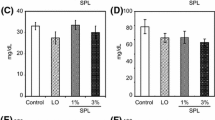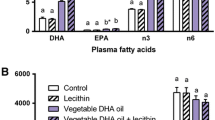Abstract
We made a comparative analysis of the uptake, tissue deposition and conversion of dietary α-linolenic acid (ALA) to its long chain metabolites eicosapentaenoic acid (EPA) and docosahexaenoic acid (DHA) with preformed EPA + DHA. Diets containing linseed oil [with ALA at ~2.5 (4 g/kg diet), 5 (8 g/kg diet), 10 (16 g/kg diet), 25% (40 g/kg diet)] or fish oil [with EPA + DHA at ~1 (1.65 g/kg diet), 2.5 (4.12 g/kg diet), 5% (8.25 g/kg diet)] or groundnut oil without n-3 polyunsaturated fatty acids (n-3 PUFA) were fed to rats for 60 days. ALA and EPA + DHA in serum, liver, heart and brain increased with increments in the dietary ALA level. When preformed EPA + DHA were fed, the tissue EPA + DHA increased significantly compared to those given ALA. Normalized values from dietary n-3 PUFA to tissue EPA + DHA indicated that 100 mg of dietary ALA lead to accumulation of EPA + DHA at 2.04, 0.70, 1.91 and 1.64% of total fatty acids respectively in liver, heart, brain and serum. Similarly 100 mg of preformed dietary EPA + DHA resulted in 25.4, 23.8, 15.9 and 14.9% of total fatty acids in liver, heart, brain and serum respectively. To maintain a given level of EPA + DHA, the dietary ALA required is 12.5, 33.5, 8.3 and 9.1 times higher than the dietary EPA + DHA for liver, heart, brain and serum respectively. Hence the efficacy of precursor ALA is lower compared to preformed EPA + DHA in elevating serum and tissue long chain n-3 PUFA levels.
Similar content being viewed by others
Abbreviations
- ALA:
-
α-Linolenic acid (18:3 n-3)
- ANOVA:
-
Analysis of variance
- ARA:
-
Arachidonic acid (20:4 n-6)
- DHA:
-
Docosahexaenoic acid (22:6 n-3)
- DPA:
-
Docosapentaenoic acid (22:5 n-3)
- EPA:
-
Eicosapentaenoic acid (20:5 n-3)
- FO:
-
Fish oil
- GNO:
-
Groundnut oil (peanut oil)
- HDL:
-
High density lipoprotein
- LDL:
-
Low density lipoprotein
- LNA:
-
Linoleic acid (18:2 n-6)
- LSO:
-
Linseed oil
- ND:
-
Not detected
- PUFA:
-
Polyunsaturated fatty acid (s)
- SD:
-
Standard deviation
- SFA:
-
Saturated fatty acid
References
Graham CB, Philip CC (2005) Conversion of α-linolenic acid to longer-chain polyunsaturated fatty acids in human adult. Reprod Nutr Dev 45:581–597
Davis BC, Kris-Etherton (2003) Achieving optimal essential fatty acid status in vegetarians: current knowledge and practical implications. Am J Clin Nutr 78(suppl):640S–646S
Li D, Sinclair AJ, Wilson A, Nakkote S, Kelly F, Abedin L, Mann NJ, Turner AJ (1999) Effects of dietary alpha linolenic acid on thrombotic risk factors in vegetarian men. Am J Clin Nutr 69:872–882
Bazinet RP, Douglas H, Cunnane SC (2003) Whole body utilization of n-3 PUFA deficient rats. Lipids 38:187–189
Mantzioris E, James MJ, Gibson RA, Cleland LG (1995) Differences exist in the relationship between dietary linoleic and alpha linolenic acids and their respective long chain metabolites. Am J Clin Nutr 61:320–324
Lauritzen L, Hansen HS (2003) Which of the n-3 fatty acids should be called essential? Lipids 38:889–891
Anonymous (1977) Report on the American institute of nutrition, Ad-hoc committee on standards for nutritional studies. J Nutr 107:1340–1348
Folch J, Lee M, Sloane SGH (1957) A simple method for isolation and purification of total lipids from animal tissues. J Biol Chem 226:497–509
Searcy RL, Bergquist LM (1960) A new color reaction for the quantification of cholesterol. Clin Chim Acta 5:192–199
Warnick GR, Albers JJ (1978) A comprehensive evaluation of the heparin-manganese chloride precipitation procedure for estimating HDL-cholesterol. J Lipid Res 19:65–76
Stewart JCM (1980) Colorimetric estimation of phospholipids with ammonium ferrothiocyanate. Anal Biochem 104:10–14
Fletcher MJ (1968) A colorimetric method for estimating serum triacylglycerol. Clin Chim Acta 22:303–307
Morrison MR, Smith M (1963) Preparation of fatty acid methyl esters and dimethylacetyls from lipids with boron fluoride methanol. J Lipids Res 5:600–608
Fisher RA (1970) Statistical methods for researcher workers, 14th edn. Oliver and Boya, Edinburg
Ballihaut CP, Lengelier B, Houlier F, Alessandril JM, Durand G, Latge C, Guesnet P (2001) Comparative bioavailability of dietary alpha-linolenic and docosahexaenoic acids in the growing rat. Lipids 36:793–800
Valenzuela A, Bernhardi R, Valenzuela V, Ramirez G, Alarcon R, Sanhueza J, Nieto S (2004) Supplementation of female rats with alpha-linolenic acid or docosahexaenoic acid leads to the same omega-6/omega-3 LC-PUFA accretion in mother tissues and in fetal and newborn brains. Ann Nutr Metab 48:28–35
Bazinet RP, McMillan EG, Cunnane SC (2003) Dietary alpha-linolenic acid increases the n-3 PUFA content of sow’s milk and tissues of the suckling piglet. Lipids 38:1045–1049
Burdge GC, Jones AE, Wootton SA (2002) Eicosapentaenoic acid and docosahexaenoic acids are the principal products of alpha linolenic acid metabolism in young men. Br J Nutr 88:355–363
Leyton J, Drury P, Crawford M (1987) Differential oxidation of saturated and monounsaturated fatty acids in vivo in rat. Br J Nutr 57:383–393
Cunnane SC, Anderson MJ (1997) The majority of dietary linolenate in growing rats is beta-oxidized or stored in visceral fat. J Nutr 127:146–152
Bazinet RP, MacMillan EG, Seebaransing R, Hayes AM, Cunnane HC (2003) Whole-body beta oxidation of 18:2 w-2 and 18:3 w-3 in the pig varies markedly with weaning strategies and dietary 18:3 w3. J Lipid Res 44:314–319
MacDonald-Wicks LK, Gard ML (2004) Incorporation of n-3 fatty acids into plasma and liver lipids of rats: importance of background dietary fat. Lipids 39:545–551
Fu Z, Sinclair AJ (2000) Increased alpha-linolenic acid intake increases the tissue alpha-linolenic acid content and apparent oxidation with little effect on tissue docosahexaenoic acid in the guinea pig. Lipids 35:395–400
Pawlosky RJ, Hibbelin JR, Novotny JA, Salem J Jr (2001) Physiological compartmental analysis of alpha-linolenic acid metabolism in adult humans. J Lipid Res 42:1257–1265
Sinclair AJ, Crawford MA (1972) The incorporation of linolenic acid and docosahexaenoic acid into liver and brain lipids of developing rats. FEBS Lett 26:127–129
Cunnane SC, Ryan MA, Nadeau CR, Bazinet RP, Velso KM, McCloy U (2003) Why is carbon from some polyunsaturates extensively recycled into lipid synthesis? Lipids 38:477–484
Christiansen EN, Lund JS, Rortveit T, Rustan AC (1991) Effect of dietary n-3 and n-6 fatty acids on fatty acid desaturation in rat liver. Biochim Biophys Acta 1082:57–62
Emken EA, Adolf RO, Duval SM, Nelson GJ (1999) Effect of dietary docosahexaenoic acid on desaturation and uptake in vivo of isotope labeled oleic, linoleic and linolenic acids by male subjects. Lipids 34:785–791
Emken EA, Adlot RO, Gulley RM (1994) Dietary linoleic acid influences desaturation, elongation and acylation of deuterium labeled linoleic and linolenic acid in young adult males. Biochim Biophy Acta 1213:277–288
Croset M, Black JM, Sawnson JE, Kinsella JE (1989) Effects of dietary n-3 PUFA on phospholipids compositions and calcium transport in mouse cardiac sarcoplasmic reticulum. Lipids 24:278–285
Connor WE, Neuringer M (1988) The effects of n-3 FA deficiency and repletion upon the FA composition and function of the brain and retina. Prog Clin Biol Res 282:275–294
Greiner RS, Moriguchi T, Hutton A, Slotnick BM, Salem N Jr (1999) Rats with low levels of brain docosahexaenoic acid show impaired performance in olfactory based and spatial learning task. Lipids 34:S239–S243
Ahmed A, Moriguchi T, Salem N Jr (2002) Decrease in neuron size in DHA deficient brain. Pediatr Neurol 26:210–218
Lin DS, Connors WE (1990) Are the n-3 FA from dietary fish oil deposited in the triglyceride stores of adipose tissue. Am J Clin Nutr 51:535–539
Kajwara MOK, Imai S, Koboyashi T, Honma N, Maki T, Suruga K, Goda T, Takase S, Muto Y, Moriwaki H (1997) Perilla oil prevents excessive growth of visceral adipose tissue in rats by down regulating adipocyte differentiation. J Nutr 127:1752–1757
Abedin L, Lien E, Vingnys AJ, Sinclair AJ (1999) The effect of dietary alpha linolenic acid compared with docosahexaenoic acid on brain, retina, liver and heart in guinea pig. Lipids 34:475–482
Sinclair AJ (1975) Incorporation of radioactive polyunsaturated fatty acids into liver and brain of the developing rat. Lipids 10:175–184
Greiner RC, Winter J, Nathanielsz PV, Brenna JT (1997) Brain docosahexaenoate accretion in fetal baboons: bioequivalence of dietary alpha-linolenic acid and docosahexaenoic acid. Pediatr Res 42:826–834
Sinclair AJ, Attar Bash NM, Li D (2002) What is the role of alpha-linolenic acid for mammals. Lipids 37:1113–1123
Bourre JM, Dumont O, Pascal G, Durand G (1993) Dietary α-linolenic acid at 1.3 g/kg maintains docosahexaenoic acid concentration in brain, heart and liver of adult rats. J Nutr 123:1313–1319
Hwang DH, Boudreau M, Chanmugam P (1988) Dietary linoleic acid and longer chain n-3 fatty acids: comparison of effects on arachidonic acid metabolism in rats. J Nutr 118:427–437
Igarashi M, DeMar JC, Ma K, Chang L, Bell JM, Rapoport S (2007) Up regulated liver conversion of α-linolenic acid to docosahexaenoic acid in rats on a 15 week n-3 PUFA-deficient diet. J Lipid Res 48:152–164
Acknowledgments
T.R. Ramaprasad acknowledges a Senior Research Fellowship grant from the Council of Scientific and Industrial Research, New Delhi, India. The authors thank Dr. Visheweshwariah Prakash, Director, CFTRI for his suggestions in the manuscript preparation.
Conflict of interest
All authors have no conflict of interest.
Author information
Authors and Affiliations
Corresponding author
About this article
Cite this article
Talahalli, R.R., Vallikannan, B., Sambaiah, K. et al. Lower Efficacy in the Utilization of Dietary ALA as Compared to Preformed EPA + DHA on Long Chain n-3 PUFA Levels in Rats. Lipids 45, 799–808 (2010). https://doi.org/10.1007/s11745-010-3464-6
Received:
Accepted:
Published:
Issue Date:
DOI: https://doi.org/10.1007/s11745-010-3464-6




